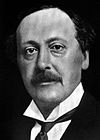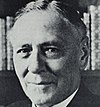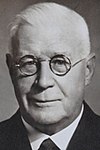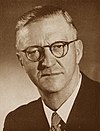Governor-General of South Africa
| Governor-General of the Union of South Africa | |
|---|---|
| Goewerneur-generaal van die Unie van Suid-Afrika (Afrikaans) Goeverneur-generaal van de Unie van Zuid-Afrika (Dutch) | |
Charles Robberts Swart | |
| Abolished | 31 May 1961 |
The governor-general of the Union of South Africa (
Some of the first holders of the post were members of the
The office was established by the South Africa Act 1909. Although the governor-general was nominally the country's chief executive, in practice he was bound by convention to act on the advice of the prime minister and the cabinet of South Africa.
Republicanism

The Afrikaner-dominated
In 1957,
However, it was not until 1960 that Prime Minister Hendrik Verwoerd advised Governor-General Swart to hold a referendum on the issue. After several protests regarding the lowering of the voting age to 18, and the inclusion of white voters in South West Africa, on 5 October 1960 white South Africans were asked: Are you in favour of a Republic for the Union? The result was 52 per cent in favour of the change.
Swart, the last governor-general, asked Queen
List of governors-general of South Africa
The following is a list of people who served as governor-general of South Africa from independence in 1910 to the establishment of a republic in 1961.
Symbols
- ^† Died in office.
| No. | Portrait | Name (Birth–Death) |
Term of office | Monarch (Reign) | ||
|---|---|---|---|---|---|---|
| Took office | Left office | Time in office | ||||
| 1 | 
|
The Viscount Gladstone (1854–1930) |
31 May 1910 |
8 September 1914 |
4 years, 100 days |  George V (1910–1936) |
| 2 | 
|
The Viscount Buxton (1853–1934) |
8 September 1914 |
17 November 1920 |
6 years, 70 days | |
| 3 | 
|
Prince Arthur of Connaught (1883–1938) |
17 November 1920 |
21 January 1924 |
3 years, 65 days | |
| 4 | 
|
The Earl of Athlone (1874–1957) |
21 January 1924 |
26 January 1931 |
7 years, 5 days | |
| 5 | 
|
The Earl of Clarendon (1877–1955) |
26 January 1931 |
5 April 1937 |
6 years, 69 days | |
| 6 | 
|
Sir Patrick Duncan (1870–1943) |
5 April 1937 |
17 July 1943[†] |
6 years, 103 days |  George VI (1936–1952) |
| — | 
|
Nicolaas Jacobus de Wet (1873–1960) Officer Administering the Government |
17 July 1943 |
1 January 1946 |
2 years, 168 days | |
| 7 | 
|
Gideon Brand van Zyl (1873–1956) |
1 January 1946 |
1 January 1951 |
5 years | |
| 8 | 
|
Ernest George Jansen (1881–1959) |
1 January 1951 |
25 November 1959[†] |
8 years, 328 days | |
| — | 
|
Lucas Cornelius Steyn (1903–1976) Officer Administering the Government |
26 November 1959 |
11 December 1959 |
15 days |  Elizabeth II (1952–1961) |
| 9 | 
|
Charles Robberts Swart (1894–1982) |
11 December 1959 |
30 April 1961 |
1 year, 140 days | |
| — | 
|
Lucas Cornelius Steyn (1903–1976) Officer Administering the Government |
30 April 1961 |
31 May 1961 |
31 days | |
Flag of the governor-general
-
1910–1931
-
1931–1953
-
1953–1961
See also
Notes
- ^ Contemporary Dutch spelling used in South Africa from 1905 to 1925. Modern Dutch spelling: Gouverneur-generaal van de Unie van Zuid-Afrika





